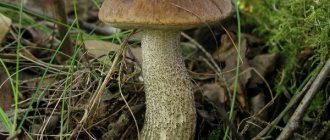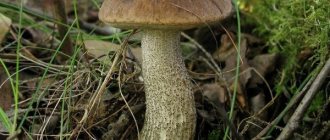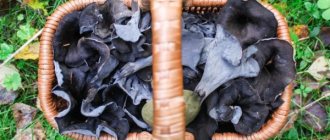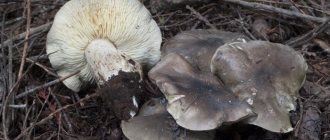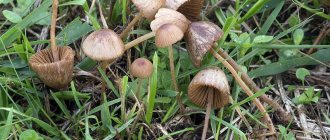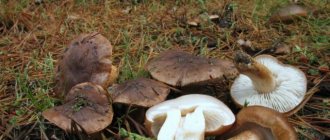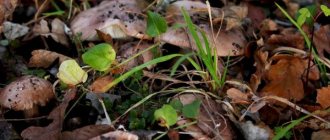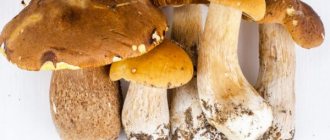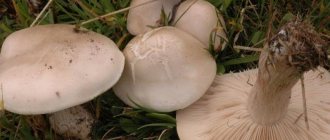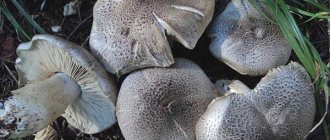Description and features of the mushroom
The mushroom is called row, because they grow only in groups; these mushrooms cannot be found individually. There is a row of both poisonous and edible. The mushroom is a cap-shaped mushroom; its external characteristics are quite variable. On the territory of Russia there are more than 15 varieties of row mushroom, each of them has its own shape, size and taste.
- Hat. The diameter of the mushroom cap is about 10 centimeters; six-centimeter caps are less common. The top has a gray-white tint, feels dry and dull. If the mushroom is already old, then a yellow spot with specks appears in the middle of the cap. A young mushroom has a convex cap, where the edges are slightly curled; the older the mushroom, the more its surface becomes prostrate and convex.
- Leg. As for the leg, it is dense, the color is the same as that of the cap, but as it ages, it acquires a light brown tint under the cap. The length can reach 10 centimeters, but there are also five-centimeter legs.
- The plates of the white row are wide and located next to each other. In a young mushroom they are white, but when the mushroom ages, they acquire a yellow tint.
- The pulp of the row is dense, rich, and white in color. If you break it, you can see the pink color inside. If the mushroom is still young, then there is no smell, but as it matures, it acquires a rotten aroma, somewhat reminiscent of radish.
Similar species
- Common champignon.
It is somewhat similar to row, but it does not have an unpleasant odor, and its plates turn pink and then darken with age.
- The row is smelly.
This is also an inedible mushroom, the cap of which has light shades, but is also colored brown. In this case, the plates are located quite rarely.
1-Common champignon. 2-Row is smelly.
Chemical value of the mushroom
The white row has a fairly large composition, here you can see what benefits it can bring to a person:
- Vitamin (A, B, C, D (2.7), K, PP and betaine.
- Potassium and calcium, phosphorus and iron, sodium and zinc, manganese.
- Lysine and threonine, alanine and phenylalanine.
- Acid (glutamic, aspartic, stearic).
- Ergosterol and phenols.
- Flavonoids and polysaccharides.
Based on research, scientists have found that the mushroom is able to kill pathogenic bacteria, eliminate or prevent the virus, relieve the inflammatory process and increase immunity. It is also recommended to use rowing in combination with the main treatment for:
- diabetes mellitus;
- unstable blood pressure;
- arrhythmias;
- rheumatism;
- mental problems;
- diseases of the genitourinary system;
- cancer
Use in cooking
The conditional toxicity of the species allows it to be used in very small quantities for various dishes - mainly baked ones. But this is a dubious undertaking, since the white row has such an unpleasant odor that it can spoil even the most delicious dish. It’s better to simply abandon the idea of using it and opt for other ingredients.
Important! It is worth remembering that with any method of processing mushrooms, toxins do not disappear, but, in some cases, only accumulate.
Edibility of the row
Basically, the row is not an edible species, but among them there are also those that can be eaten after boiling. It is almost impossible to distinguish between an edible and a poisonous mushroom on your own; only experienced mushroom pickers can do this. They also share their experience on how to distinguish an edible mushroom from an inedible one: if the caps have a smooth shape and a beautiful white color in good daylight, then they are poisonous and should not be eaten.
Mushrooms that can be eaten always come in any color - purple, pink, lilac, yellow, and so on. In addition, bad mushrooms have an unpleasant specific smell, which cannot be said about good mushrooms. Therefore, if a person is not sure what kind of mushroom is growing in front of him, it is better not to touch it and go pick other mushrooms.
People with the following conditions should not eat mushrooms:
- low acidity;
- gallbladder problems;
- chronic gastrointestinal pathologies;
- pancreatitis;
- cholecystitis.
Interesting Facts
The row is white.
- Inexperienced mushroom pickers sometimes confuse White Ryadovka with Common Champignon and prepare dishes from them, the taste of which is quite pungent. Therefore, it is important to learn how to reliably distinguish between the two species.
- The row often forms so-called witch rings. Initially, several mushrooms settle in the clearing, which produce powerful mycorrhiza. Under favorable conditions, it grows radially, so new mushrooms appear at the same distance from the first, forming a circle. As a result, several such circles are formed, which are called witch rings.
Symptoms of poisoning
A person may not be able to distinguish an edible row from a poisonous one, and then a couple of hours after consumption, poisoning occurs, which is expressed by the following symptoms:
- general malaise;
- nausea with vomiting;
- increased salivation;
- diarrhea;
- stomach pain.
If even a few symptoms are noticed, you should urgently consult a doctor so that he can rinse the stomach and prescribe cleansing medications. If you do not seek help in time, hallucinations and other serious health problems are possible.
Similar species and their interesting properties.
Earthy or earthy gray (tricholoma terreum)
They were nicknamed “babies” for the characteristic fluffy surface of their hats. It was considered an edible mushroom until 2014. Scientists from China managed to induce rhabdomyolysis (extreme myopathy syndrome, the destruction of muscle tissue) in mice using a high dosage of tricholoma earthen extract.
Booted row (Tricholoma caligatum)
It is one of the edible mushrooms. They are often called matsutake, which means “pine mushroom.” This name is associated with the symbiosis of the shoeed row with the roots of coniferous trees. It has a relatively high price because it has antibacterial properties. During heat treatment, the unpleasant taste disappears. If matsutake is fried, it will have a sweet aftertaste. Good for pickling.
Yellow-red (Tricholomopsis rutilans)
In some areas it is listed in the Red Book. A little-known mushroom of the fourth category. It was considered unsuitable for use, since it was not listed as edible in the GOST list during USSR times. Not bad mixed with other mushrooms.
Purple talker (Lepista nuda)
It is conditionally edible. Boiling in brackish water for 15-20 minutes before further cooking reduces the risk of poisoning. Children under 7 years of age, people with chronic gastrointestinal diseases and allergy sufferers are not recommended for use. There are several poisonous look-alikes. Purple talker contains a large amount of vitamin B1 and has an antibiotic and antitumor effect.
Poplar tricholoma
It does not have any pronounced special taste properties. But according to fans of poplar row, proper preparation and application of recipes intended for this purpose will provide an exquisite nutty taste. The pulp is close to meat in terms of the number of amino acids, but does not exceed 23 kcal.
Sulfur-yellow tricholoma (Tricholoma sulphureum)
In some reference books it is described as an inedible mushroom, but in Russia it is considered poisonous due to its mild toxicity.
Green rower (tricholoma flavovirens)
Until recently, it was considered a non-poisonous mushroom of low nutritional quality (fourth category), but it turned out to be poisonous. If consumed frequently in large quantities, it causes life-threatening destruction of muscle tissue. Scientists take into account the fact that the study results appear to be very inaccurate. According to the author of the article on the topic, he prefers to treat them rather critically, but consuming greenfinches, taking into account the level of risk, is not worth it.
Benefits and harms
Each mushroom can cause some degree of harm to the body and, conversely, benefit. To do this, it’s worth understanding and weighing all the pros and cons.
Benefit. The mushroom, called row, is very useful for the body (if it is edible), since it has a positive effect on the gastrointestinal tract. These mushrooms also promote cell renewal and the removal of waste and toxins.
Harm. Any mushroom, including the row mushroom, absorbs all dust, dirt and metals; this mainly applies to old mushrooms, because if the mushroom has outgrown, then it is not recommended to eat it. You should not eat a lot of mushrooms, as they are heavy food for the stomach and may cause flatulence, abdominal pain and nausea.
Interesting information:
- in some countries, rowing is considered a real delicacy; they are grown and sold for export;
- powder extracted from row mushrooms is often used in cosmetology to get rid of acne.
Application in medicine
Despite the negative nutritional properties, white row, like other mushrooms of this species, is used in medicine . It is part of antidiabetic drugs, antibiotics, and drugs that reduce the activity of cancer.
Traditional medicine also uses this species to make tinctures, ointments and lotions for skin diseases. In cosmetology, dried mushroom powder is used in lotion to cleanse the face.
Is it possible to grow a row yourself?
Since mushrooms often have problems even in field conditions, it will be quite difficult to grow them yourself. Rower is a finicky mushroom that requires proper care, so achieving positive results is very difficult, and in some cases completely unrealistic. To plant edible rows, you should choose a moist area protected from the sun.
The air temperature should not exceed 15 degrees, and the ground 20 degrees. Therefore, it will not be possible to grow them outside; for this you need greenhouses with a set temperature. Mushrooms can be planted using both spores and mycelium.
How to plant seeds (spores)?
The first thing you should do is go to the forest for a few mushrooms; the main thing is not to confuse an edible mushroom with a poisonous one. You need to choose a young, healthy mushroom without rot, yellow spots and worms. The mushroom caps are cut off and ground into powder; they contain many seeds. After which it should be soaked in potassium permanganate in a ratio of 1 gram per 9 liters of water. Leave for 5 hours.
Spores are planted in a mixture of horse manure, foliage and pine needles or on a substrate of champignon mushrooms. The pre-soaked mass is simply poured onto the bed and covered with substrate on top. Planting is done in the spring in order to get fruits in the fall.
How to grow mycelium (mycelium)?
Seedlings with mycelium can be obtained in several ways:
- Dig in the forest.
- Grow at home.
- Buy from a specialty store.
If you decide to dig in the forest, then it’s easy to do, you just need to find a clearing where these mushrooms grow and dig out the soil around them. A piece of 20 by 10 by 10 centimeters is enough. After which this land is planted in the garden and filled with substrate.
Buying mycelium is quite difficult, since it is rarely found on the market. In addition, there is a danger that the seller will slip in the wrong mycelium or a completely dead one that does not bear fruit.
Appearance of the white row
Porcini mushrooms are inedible and hazardous to health. Therefore, they are not used in medicine and cooking. The species is not grown at home or in mushroom production. Everything is exactly the opposite: poisonous fruiting bodies are removed from the site using chemical methods and digging up the soil.
White rower lives in deciduous and mixed forests, and is found under single coniferous trees. It is found in groves and parks. It grows in groups and actively bears fruit from July to September. In Russia it predominates in the European part of the country.
Description of the white row:
- The diameter of the cap is up to 10 cm. The shape is prostrate, with concave, uneven edges. In old fruiting bodies it is brown or brown, with spots. The skin is dry, not shiny, slightly rough.
- The leg is visually clearly separated from the cap and has a cylindrical shape. Its length ranges from 5 to 10 cm. Sometimes there is a powdery coating at the top. Expanding downward, it forms a small tuberous thickening. There is no filmy “skirt” on it. The density is elastic, not hollow.
- The pulp is dense, fleshy, turns pink when broken, may have a sharp musty smell, in some it has the aroma of hyacinths. The taste is bitter and pungent.
- The plates match the color of the pulp, turning yellow with age. The powder formed by the spores is white.
How to cook and where can you use the mushroom?
This type of mushroom has properties similar to antibiotics, so it is made in the form of a tincture. But this technique has not been confirmed and has not undergone clinical trials.
A quick and common way is to boil mushrooms. Before cooking, the mushrooms are washed well under running water, peeled, then washed again and boiled in salted water. Cooking time – 20 minutes.
Ryadovka is a fairly common mushroom, but it has many varieties, both edible and poisonous. Therefore, it is very important to either be an experienced mushroom picker or take one with you so that you don’t get poisoned. This type of mushroom can be grown in your own garden, but it is not a fact that everything will end positively.
0
0
Copy link
Is it possible to eat?
This type of tricholoma is considered inedible (poisonous in some sources) and can cause poisoning. The reason for the toxic effect of the fruit on the human body is its high content of toxins.
Some people who have risked eating it speak of its meatiness and satiety, but the smell of the liquid remaining after cooking (boiling in water) is nauseating. This saturation method is useful in an extremely extreme situation. It is difficult to be poisoned by this type of “ordinary mushroom” with a fatal outcome, since the amount of toxin in the mushroom is insufficient, but intoxication is quite possible.
Characteristic features of the variety
This mushroom is noticeable from a distance with its specific pale color, and an inexperienced mushroom picker may confuse it with champignons. Upon closer examination, characteristic differences from other species are visible.
Appearance and photo
White row is a lamellar mushroom.
Appearance Features:
- the surface is smooth, color – from pure white to milky;
- cap with curved edges, up to 10 cm in diameter;
- a cylindrical fibrous stalk approximately 10 cm high and up to 2 cm in diameter;
- The pulp is dense, turns pink in places where it is broken.
It is imperative to remember this mushroom, since when eaten it immediately causes distress and even poisoning.
Morphology
Belongs to the family Tricholomaceae, or Rowaceae, genus - Tricholoma, species - White rower. It has a structure typical of its genus.
The following species markers can be called:
- The cap has a convex shape, which straightens and becomes flat during aging. In this case, the color practically does not change, but in older mushrooms a yellowish tint appears in the middle.
- The leg is elastic, widened upward, and has a powdery coating. It feels quite dense to the touch, you don’t feel any airiness.
Description of the mushroom
- The plates are white, frequent and wide; they can become yellow in old mushrooms.
- The pulp is dense, white, odorless in young specimens. During the ripening period of the mushroom, an unpleasant musty odor appears.
Mushrooms grow in symbiosis with coniferous trees and birch trees and take deep roots, which allows them to maintain breeding sites for several years.
Place of distribution
The habitat of this species is the European continent. It is especially characteristic of Russian forests in the western part of the country and the Primorsky Territory. The mushroom is widespread in deciduous and mixed forests of temperate latitudes. Selects acidic soils for reproduction.
She prefers open space and can be found on forest edges, meadows, and in places where there is grass. Like all tricholomas, it does not grow singly, but in clusters of ten or more specimens.
The period of growth and fruiting of the row covers the period from July to mid-October, but it can be longer, depending on weather conditions.
Eating
Despite the fact that many types of rows are edible and delicious dishes are prepared from them, the white one is inedible, and in some sources it is even listed as semi-poisonous. The mushroom has an unpleasant odor, is very persistent, and its taste can be described as bitter and pungent.
It’s definitely not worth adding such mushrooms to your diet. Tasting white rower can lead to indigestion and even serious poisoning. You should be vigilant when going to the forest so as not to bring such tricholoma home by mistake.
Eating rows of vegetables
The only area of use of this mushroom is traditional medicine. Alba extract is sometimes used in ointments and tinctures to combat wrinkles and skin diseases (acne, enlarged pores, increased oiliness). But the preparation of such medicines is not popular, so you should not try to prepare such preparations yourself.
Growing at home
May mushroom is one of the few species intended for growing at home. Following all the rules for growing will help you harvest for several months. The technology for growing Mayska row is simple and even a beginner can handle it. For the development of mycelium, it is necessary to maintain a temperature regime of +20 o C. Within 2-3 weeks, the mycelium will acquire a purple tint. At this time, it must be covered with a layer of soil of 0.5 cm. Future rows must be covered, protected from sunlight and temperature conditions created at 10-15 o C. The first fruiting can be noticed after 3 weeks. After the first shoots appear, you can remove the shelter. Soil moisture is a very important condition when growing mushrooms. If the soil is too moist, the mycelium will not allow young shoots to emerge; if the soil is dry, young shoots will die. After each harvest, it is necessary to update the top layer of soil.
Medicinal properties
Probably one of the important criteria for growing the May mushroom is the ability of its enzymes with the tuberculosis bacillus. Therefore, the row is actively used in the pharmaceutical industry for the production of antibiotics to combat tuberculosis. It has been scientifically proven that regular consumption of mayweed will help:
- remove waste and toxins from the body;
- restore liver cells;
- normalize gastric and intestinal tone;
- boost immunity.
- reduce nervous disorders;
- normalize blood sugar levels;
- strengthens bones and blood vessels;
- improve the condition of the cardiovascular system.
Important! The information presented in the material is for informational purposes only. Before use, be sure to consult a specialist.
May mushroom contains anti-cancer components that are widely used in Chinese medicine, using it to make medicines against cervical and ovarian cancer.
Medicinal properties of May row:
- anti-inflammatory;
- antiviral;
- antibacterial;
- antioxidant.
Difference from edible mushrooms
The porcini mushroom has several similar counterparts that are quite suitable for consumption. This:
- Champignon - looks quite similar to the row.
You can distinguish tricholoma by its fetid odor, but champignon will have a pleasant mushroom aroma. Another clue will be the dark plates of the champignon and the white rows. The last difference is the absence of a ring on the tricholoma stalk. - May tricholoma is very similar in color and shape to its poisonous counterpart, but is absolutely safe for human life and has a pleasant taste and smell, similar to the aroma of fresh flour.
It differs from the white row in color - milky white, even cream, with narrow plates attached to the stem. It is believed that it is very difficult to catch a May mushroom in the forest at the same time as a poisonous one, since they have different ripening periods. The May row grows from the end of April to the end of July, and the white one begins to grow only in August.
It is imperative to take into account the differences between mushrooms and the features that can help you protect yourself from collecting poisonous fruits. Particular attention should be paid to poisonous mushrooms similar to white mushrooms.
You may be interested in:
What does the boletus mushroom look like and its description (20 photos) One of the most common edible mushrooms in our country, which is equated in taste with porcini mushroom...Read more...
So, it is easy to confuse it with the stinking row, which has a typical unpleasant odor, but looks very similar to the white one. If the latter is inedible due to its bitter taste and ability to cause eating disorders, then the former is a truly poisonous mushroom that is dangerous to human health.
Rehabilitation and preventive measures
For some time after treatment, the patient should not drink alcohol or eat mushrooms. Canned foods cause botulism, which is also treated in a hospital. Prevention measures include:
- Selectively collect forest mushrooms (only familiar ones) and do not pick species unknown to you.
- Never attempt to consume even processed inedible or poisonous specimens.
- Re-sort trophies, carefully process even edible ones.
- Do not buy mushrooms from your hands.
- Do not eat a lot of mushrooms at once, even if they are processed. They are considered heavy food.

